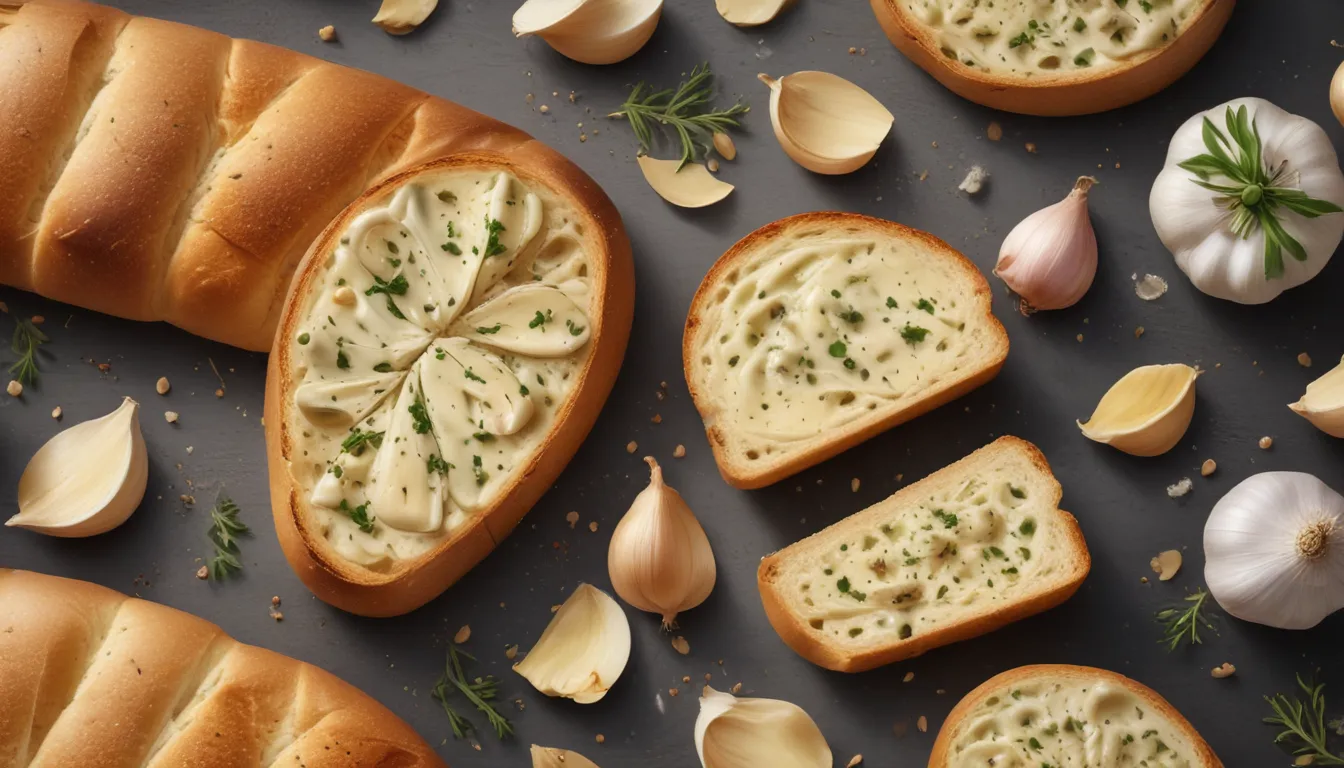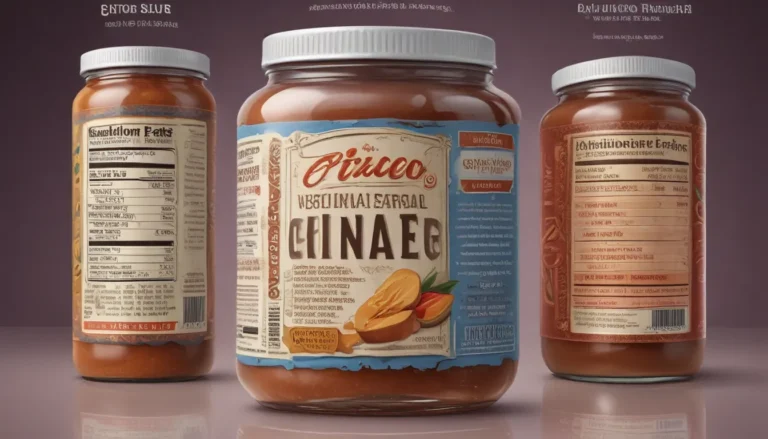The pictures in our articles might not always show exactly what the text is talking about. We use these images to make the article more interesting and eye-catching. They are there to add to the text, but not to replace it or show every detail.
Garlic bread, with its tantalizing aroma and flavorful taste, is a beloved addition to many meals across the globe. But have you ever wondered about its nutritional value? In this article, we will delve into the world of garlic bread and uncover 15 fascinating nutrition facts that shed light on its ingredients, health benefits, and key nutritional information. Get ready to discover the delicious secrets of garlic bread!
The Foundation: Versatile Bread Base
The journey of garlic bread often begins with a base of bread, typically a baguette or loaf, providing essential carbohydrates and dietary fiber. Whether it's white bread, whole wheat, or gluten-free options, the type of bread used can vary to suit different preferences.
The Star Ingredient: Flavorful Garlic Infusion
At the heart of garlic bread lies the star ingredient – garlic. Not only does garlic add a unique and aromatic flavor, but it also comes packed with potential health benefits. Allicin, a compound found in garlic, boasts antimicrobial and antioxidant properties, making it a valuable addition to your diet.
Decadent Coating: Butter or Olive Oil
Garlic bread often gets its rich taste and texture from a luscious coating of butter or olive oil. While butter provides a creamy flavor, olive oil brings in heart-healthy monounsaturated fats, adding a touch of goodness to this already delightful treat.
The Nutrient-Rich Garlic
Beyond its delicious taste, garlic is a low-calorie ingredient packed with essential vitamins and minerals. From vitamin C and B6 to manganese and selenium, garlic offers a range of nutrients that can support your immune system and promote cardiovascular health.
Keeping Count: Calories and Macronutrients
The caloric content of garlic bread can vary based on factors such as portion size and the amount of butter or oil used. On average, a serving of garlic bread typically ranges from 150 to 200 calories, providing a balanced mix of carbohydrates, fats, and a hint of protein.
The Fiber Boost
The fiber content in garlic bread primarily comes from the bread itself. Opting for whole wheat or multigrain varieties can offer a higher dietary fiber content compared to traditional white bread, crucial for digestive health and promoting a feeling of fullness.
Watching Your Sodium Intake
It's important to be mindful of the sodium levels in garlic bread, especially if it's made with salted ingredients like butter. Keeping an eye on your overall sodium intake is crucial, particularly if you have specific dietary requirements or health concerns to consider.
A Dash of Nutrition: Vitamin and Mineral Profile
While garlic bread may not be a powerhouse of vitamins and minerals, it does provide small amounts of essential nutrients like calcium, iron, and vitamin K. These nutrients, present in the bread and added spreads, contribute to your overall nutritional intake.
Embracing Antioxidants
Thanks to garlic's antioxidant properties, garlic bread serves as a delicious way to combat free radicals in your body. These antioxidants play a vital role in protecting your cells from oxidative stress, contributing to your overall health and well-being.
Finding Balance: Moderation and Portion Control
Like any indulgent treat, balance is key when enjoying garlic bread. While it can enhance the flavors of your meal, it's crucial to practice moderation and portion control to maintain a healthy balance in your diet without compromising on taste.
Pairing Perfection: Recipe Ideas
Garlic bread's versatility shines through as it pairs seamlessly with various dishes, from pasta and soups to salads and Mediterranean-inspired meals. Let your creativity run wild as you explore different recipes incorporating garlic bread as a delicious side or appetizer.
DIY Delights: Homemade vs. Store-Bought
Opting for homemade garlic bread allows you to have greater control over the ingredients and portion sizes. While store-bought options can vary in nutritional content, homemade versions often offer a fresher, more personalized touch without the need for preservatives or additives.
Allergy Awareness: Considerations for Allergens
Individuals with specific allergies or dietary restrictions should exercise caution when consuming garlic bread. Common allergens to watch out for include wheat/gluten and dairy (if butter is used), ensuring that your meal aligns with your dietary needs.
Healthier Alternatives: Lighter Options
For those seeking healthier choices, there are alternatives to traditional garlic bread. Whether you opt for whole wheat or multigrain bread, reduce the amount of butter or oil, or experiment with substitutes like garlic-infused olive oil or lighter spreads, there are plenty of ways to enjoy a healthier version of this classic treat.
Embracing Balance: Indulgence and Wellness
Indulging in garlic bread as part of a balanced diet is not only possible but encouraged. By making mindful choices, practicing portion control, and incorporating a variety of nutrient-rich foods into your meals, you can savor the savory delights of garlic bread while supporting your overall wellness.
The Finale: A Flavorful Conclusion
In wrapping up, garlic bread isn't just a delectable addition to your meals – it also brings certain nutritional benefits to the table. With the right ingredients and mindful portion control, you can relish the savory flavors of garlic bread while maintaining a well-rounded and healthy diet. So go ahead, experiment with different variations, and enjoy the simple joys of this cherished bread in moderation.
FAQs: Answering Your Burning Questions
Is garlic bread high in calories?
Garlic bread typically ranges from 150 to 200 calories per serving, depending on factors like portion size and the amount of added fats.
Can garlic bread be part of a healthy diet?
Yes, garlic bread can be enjoyed as part of a balanced diet when consumed in moderation and paired with nutrient-rich foods, making it a delightful treat without compromising on health.
Are there gluten-free alternatives to garlic bread?
Absolutely! Gluten-free bread options, made from grains like rice, quinoa, or almond flour, can be used to create delicious gluten-free garlic bread for those with dietary restrictions.
Can I make garlic bread without butter?
Certainly! You can opt for olive oil or garlic-infused olive oil as a healthier substitute for butter, providing a lighter and equally delicious alternative.
Can I freeze garlic bread?
Yes, you can freeze garlic bread for later use. Simply wrap it tightly in foil or place it in a freezer bag to maintain its freshness, then reheat it in the oven or toaster oven when you're ready to enjoy it again.
Before you go:
Our mission to deliver trustworthy and engaging content guides our every step. Each fact shared on our platform comes from real users like you, offering a diverse range of insights and information. Rest assured, our dedicated editors meticulously review each submission to ensure the highest standards of accuracy and reliability, guaranteeing that the facts you discover are not just fascinating but credible. Trust in our commitment to quality and authenticity as you embark on a journey of exploration and learning with us.






